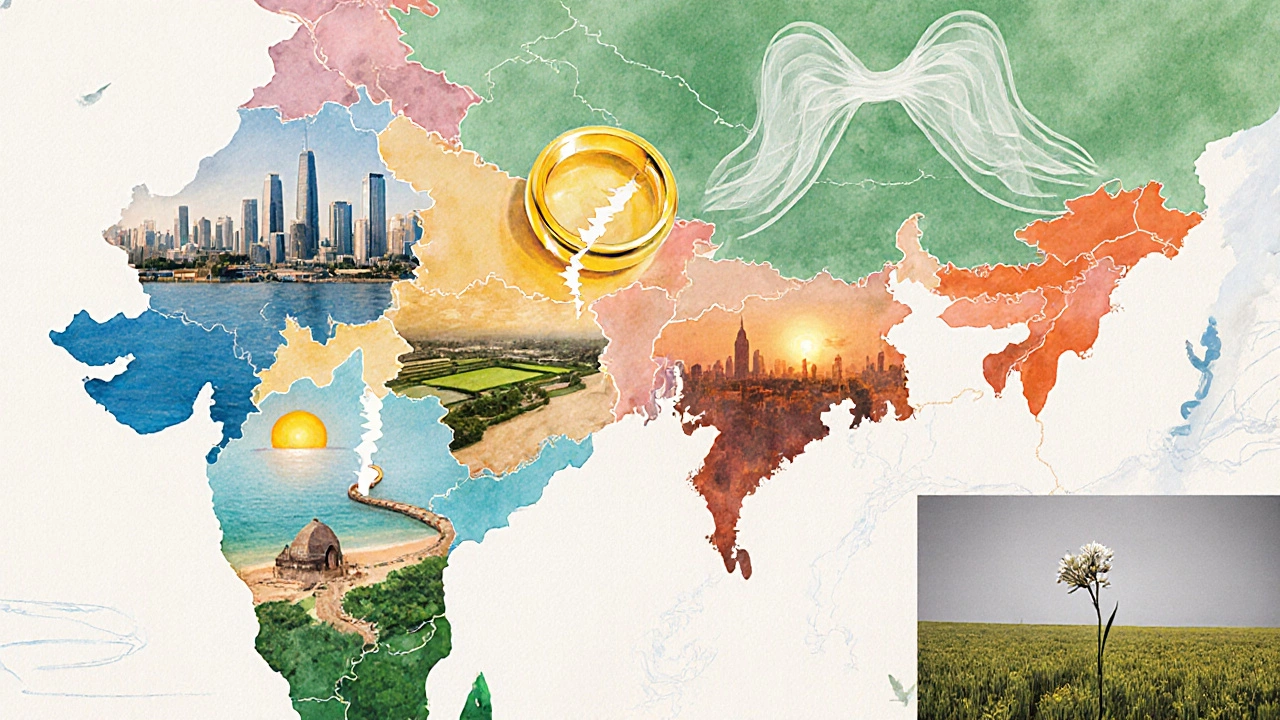India Divorce Rate Estimator
Estimate India's Divorce Rate
Input key social and demographic factors to estimate the divorce rate per 1,000 married women.
Projected Divorce Rate
Explanation: This calculator uses key factors from the article to project divorce rates based on:
- Higher urbanization typically correlates with higher divorce rates
- Women's education and employment are strong predictors of divorce
- Changing social attitudes impact divorce acceptance
When you hear people talk about “Indian weddings,” the image that pops up is usually a grand, multi‑day celebration. But what happens after the festivities end? Understanding the divorce rate India gives a clearer picture of how many couples actually stay together.
Divorce Rate in India is a demographic indicator that measures how many marriages end in legal dissolution each year.
TL;DR: Quick snapshot
- National divorce rate (2023‑24) ≈ 1.2 divorces per 1,000 married women.
- Urban areas: around 2.1 per 1,000; Rural: 0.6 per 1,000.
- Highest state rates: Delhi, Kerala, Goa; Lowest: Bihar, Uttar Pradesh.
- Key drivers: urbanisation, women’s education & employment, changing attitudes, and legal reforms.
Where do the numbers come from?
Two government sources dominate the data landscape:
- National Family Health Survey (NFHS) - a large‑scale household survey that records marital status, age at marriage and separation.
- Sample Registration System (SRS) - the official civil‑registration system that captures births, deaths and divorces reported to local authorities.
NFHS‑5 (conducted 2019‑2021) reported that 1.1 % of ever‑married women said they were currently divorced or separated. The SRS, after adjusting for under‑reporting, gave a slightly higher figure of 1.3 % for the fiscal year 2023‑24. Combining these sources gives the commonly quoted national average of about 1.2 divorces per 1,000 married women.
State‑wise picture
India’s diversity means divorce rates differ dramatically across states. The table below shows the latest SRS‑derived rates (2023‑24) for selected states.
| State / UT | Divorce rate |
|---|---|
| Delhi | 4.3 |
| Kerala | 3.9 |
| Goa | 3.5 |
| Maharashtra | 2.4 |
| Karnataka | 2.2 |
| Punjab | 1.8 |
| Uttar Pradesh | 0.5 |
| Bihar | 0.4 |
Urban centres like Delhi and metropolitan Maharashtra consistently top the list, while largely agrarian states such as Bihar and Uttar Pradesh sit at the bottom. The gap reflects differences in education, women’s labour‑force participation, and the accessibility of legal services.
Legal framework behind the numbers
India’s divorce legislation is split among several personal laws:
- Hindu Marriage Act (1955) - governs Hindus, Sikhs, Jains and Buddhists. Allows divorce on grounds like cruelty, desertion, and mutual consent after two years of separation.
- Muslim Personal Law (Sharia) - does not formally recognise divorce filings; instead, talaq (revocation of marriage) is exercised by the husband, though recent reforms aim to standardise the process.
- Special Marriage Act (1954) - covers inter‑religious unions and applies a uniform set of grounds for divorce.
Recent amendments, especially the 2021 amendment to the Hindu Marriage Act that introduced a “mutual consent” route after two years, have made it somewhat easier to dissolve a marriage. However, lengthy court backlogs - the average time to finalise a divorce in family courts exceeds 18 months - still deter many couples.

Why are divorces rising?
Several inter‑linked factors push the numbers upward:
- Urbanisation and mobility: Young adults moving to cities for work encounter new social circles, often leading to mismatched expectations.
- Women’s education: Literacy rates among women have climbed to 70 % (2021). Educated women are more likely to question unhealthy marital dynamics.
- Employment and financial independence: Female labour‑force participation rose to 23 % in 2024, giving women both the means and the confidence to leave abusive or unsatisfactory unions.
- Changing attitudes: A 2023 Pew‑Social Trends poll found that 58 % of Indian millennials view divorce as a socially acceptable option, up from 32 % in 2010.
- Legal awareness: NGOs and legal‑aid groups have increased outreach, especially in urban slums, informing couples about filing procedures.
Social stigma - still a barrier
Even with rising numbers, divorce remains a taboo in many regions. In rural Uttar Pradesh, divorced women often face ostracism and limited remarriage prospects. This cultural pressure contributes to under‑reporting; many separations are informal “live‑in” arrangements that never reach the courts.
How does India compare globally?
According to the United Nations Demographic Yearbook 2024, the global average divorce rate sits around 2.5 per 1,000 married women. India’s 1.2 figure places it well below the world average, ranking it alongside countries like Pakistan and Bangladesh. In contrast, the United States (3.2), Spain (3.0) and Russia (4.0) sit far higher.

What the future may hold
Projecting forward, three scenarios seem plausible:
- Gradual rise: If urbanisation continues at 2 % per year and women’s employment climbs to 30 % by 2030, the divorce rate could edge up to 1.8 per 1,000.
- Policy‑driven dip: Introduction of fast‑track family courts and mandatory counseling could reduce the backlog, making divorce less daunting and potentially lowering the rate of illegal separations.
- Stagnation: Persistent social stigma in large parts of the country may hold the nationwide figure steady, even as pockets of high rates persist in metros.
Regardless of the path, keeping an eye on the data helps policymakers, NGOs and even wedding planners understand the evolving landscape of Indian marriages.
Quick checklist for anyone interested in the numbers
- Look for the latest NFHS‑5 or NFHS‑6 release - they provide the most reliable household‑level data.
- Check the SRS annual report for state‑wise breakdowns.
- Consider the legal context - different personal laws affect filing ease.
- Factor in urban vs rural demographics when interpreting a figure.
- Watch social‑attitude surveys (e.g., Pew, Lokniti) for future trend clues.
Frequently Asked Questions
What is the current national divorce rate in India?
The most recent official estimate (2023‑24) puts the rate at about 1.2 divorces per 1,000 married women, according to the Sample Registration System.
Which Indian state has the highest divorce rate?
Delhi leads with roughly 4.3 divorces per 1,000 married women, followed by Kerala and Goa.
How do personal laws affect divorce proceedings?
Hindu, Sikh, Jain and Buddhist couples follow the Hindu Marriage Act, which lists specific grounds for divorce. Muslim couples traditionally rely on talaq, though recent reforms aim to standardise the process. Inter‑faith couples use the Special Marriage Act, which offers a uniform set of grounds.
Is divorce becoming socially acceptable in India?
Among urban millennials, a 2023 Pew poll showed 58 % now view divorce as socially acceptable, up from about one‑third a decade earlier. Acceptance is still lower in rural areas.
Where can I find state‑wise divorce data?
The Census of India’s Sample Registration System releases annual reports with state‑wise figures. The Ministry of Statistics and Programme Implementation also publishes summarized tables on its website.
